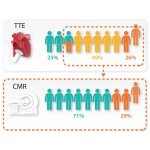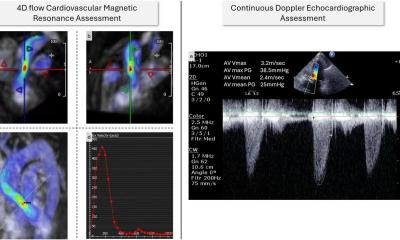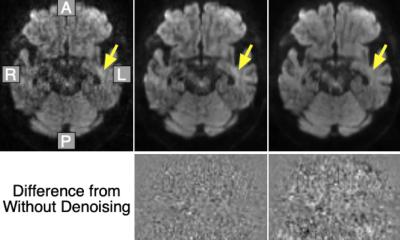© Сергей Уланов – stock.adobe.com
News • Improved detection of heart failure
New MRI model for better imaging of women's hearts
An important new study has advanced how heart failure is detected in women – meaning more female patients can be diagnosed and at an earlier stage.
Researchers led by teams from the Universities of East Anglia (UEA), Sheffield and Leeds, have been able to fine-tune how magnetic resonance imaging (MRI) is used to detect heart failure in women’s hearts, making it more accurate. Their research is published in the European Heart Journal Open.
Lead author Dr Pankaj Garg, of the University of East Anglia’s Norwich Medical School and a consultant cardiologist at the Norfolk and Norwich University Hospital, said: “By refining the method for women specifically, we were able to diagnose 16.5pc more females with heart failure. This could have huge impact in the NHS, which diagnoses around 200,0001 patients with heart failure each year. This improved method will increase early detection, meaning more women can get life-saving treatment sooner."
In 2022, UEA and the University of Sheffield published research which showed how using MRI scans could be used to detect heart failure and which led to this technique being widely employed by medics.
Recommended article

News • Cardio-imaging
MRI could revolutionise heart failure diagnosis
Using MRI scans to detect heart failure could revolutionise how the condition is diagnosed, thanks to new research from the University of East Anglia and the University of Sheffield.
When a heart starts to fail, it is unable to pump blood out effectively, and so the pressure in the heart rises. Co-author Dr Gareth Matthews, of the University of East Anglia’s Norwich Medical School, said: “Currently one of the best ways of diagnosing heart failure is to measure pressures inside the heart with a tube called a catheter. While this is very accurate, it is an invasive procedure, and therefore carries risks for patients, which limits its use. For this reason, doctors tend to use echocardiograms, which are based on ultrasound, to assess heart function, but this is inaccurate in up to 50% of cases. Using MRI, we can get much more accurate images of how the heart is working.”
Women’s hearts are biologically different to men’s. Our work suggests that in heart failure women's hearts may respond differently in response to increases in pressure
Andy Swift
The team was able to create an equation which allowed them to non-invasively derive the pressure in the heart using an MRI scanner. However, previous use of this method wasn’t as accurate as the researchers would have liked in diagnosing heart failure in women, especially in early or borderline disease. Co-author Professor Andy Swift, of the University of Sheffield’s School of Medicine and Population Health, said: “Women’s hearts are biologically different to men’s. Our work suggests that in heart failure women's hearts may respond differently in response to increases in pressure.”
Recommended article

Article • Sex differences in heart failure
Why a closer look at a woman’s heart matters
The hearts of men and women are different – while this insight has been established for quite some time now, it might even surprise cardiologists just how deep these differences really run. In her presentation at this year’s ESC, Diana Bonderman, MD, gave a comprehensive roundup on sex differences in risk factors and subtypes of heart failure.
Heart failure can be classed differently, depending on the amount of blood squeezed out of the main chamber of the heart with every beat, known as the heart’s ejection fraction. Women suffer disproportionately from a type of heart failure where the pumping function of the heart is preserved but the ability of the heart to relax and fill with blood is impaired. Echocardiography really struggles to diagnose this type of heart failure. The improvements in diagnosis from this new work will enable more of this particular cohort to be diagnosed more accurately and hopefully drive better treatments.
Co-author Dr Peter Swoboda, of the University of Leeds’ Faculty of Medicine and Health, said: “The symptoms of heart failure, like breathlessness and fatigue, can have a devastating effect on patients’ quality of life. We are increasingly recognising the importance of early diagnosis and, early treatment can improve symptoms and life expectancy. This research will help diagnose heart failure in women more quickly and get them established on life-saving treatments sooner.”
The Government’s Health and Social Care Secretary, Victoria Atkins, said: "Heart failure is a devastating condition affecting hundreds of thousands of women in the UK, so this research is a hugely positive development that could make it possible for thousands of people to get diagnosed and treated at an earlier stage. For the second year of our Women’s Health Strategy for England, I have been clear that we need more research to look at the differences between how conditions affect men and women. I am delighted that this government-backed research has met this challenge so that we can get life-saving treatment to women faster."
The research was a collaboration between the University of East Anglia, the University of Leeds, the University of Sheffield, the Norfolk and Norwich University Hospital NHS Foundation Trust, the National Heart Research Institute Singapore, Duke-NUS Medical School in Singapore, Queen Mary University of London, the National Institute for Health and Care Research’s Sheffield Biomedical Research Centre, the University of Amsterdam and Kocaeli City Hospital in Turkey. It was funded by the National Institute for Health and Care Research (NIHR) Sheffield Biomedical Research Centre, the Wellcome Trust, and the National Medical Research Council (NMRC).
Source: University of East Anglia
16.05.2024











